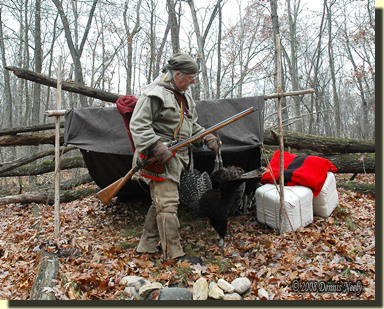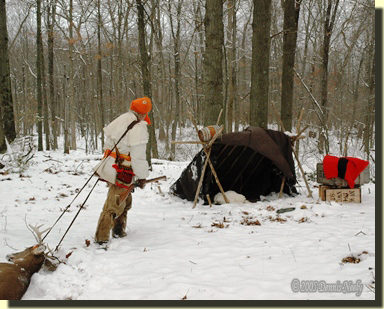Moonlight, full and bright, illuminated the hollow. Stars sparkled. Shallow breaths turned to drifting clouds. Thick frost made leaves crunch. Sixty or so paces from the brush shelter, buffalo-hide moccasins found the silence of the earthen trail that angled between two knolls. The hired hunter’s shape dropped down the slope to beside the huckleberry swamp’s stagnant water. The air smelled fresh and clean with a twinge of muck and soggy oak.
In the silvery shadows, the woodsman stepped over a downed oak limb. Another waited thirty paces distant. That was a familiar course, a quick byway to the two tiny islands in the River Raisin’s bottom land, deep in the Old Northwest Territory. The year was 1796, mid-week, late November.
Two of the scarlet trade blanket’s corners gathered frost as they flapped against twigs, limbs and clumps of sedge grass. Before the huckleberry swamp trail, Samuel the Trader’s meat gatherer paused and folded the outer layer of the blanket up over his shoulders, forming a cape of sorts for added warmth.
A different trail crossed through the muck and mire that surrounded Tamara’s Island. Green, skunk cabbage sprouts, encircled with unfrozen black ooze, dotted the sides of this path. Moccasin steps, now progressing slow in a cautious still-hunt, circled to the east. An owl hooted. A hundred or so paces beyond, at the island’s north edge, cautious footfalls chose safe passage upon moss-covered limbs and root clumps, avoiding the vicious puddles of standing water and treacherous bog holes.
Yellow birch trees mixed with the maples and white ash saplings before thinning where the red willows, poison sumac and cattails started. Here and there the scrawny birches grew together. Three in particular formed a wilderness chair-back. Their roots, covered with a layer of moss, formed a calf-high, padded seat. Seven geese flew over. “Kee-honk, kee-honk, yonk, yonk,” they hollered with set wings.
The hunter’s right moccasin cleared away the frost and crusty snow. He pulled the blanket up around his neck and sat with the island to his back. He faced in the direction of the winding Raisin. Before him, a deer trail traversed the bottom from northeast to southwest…
George Nelson’s Resources List
George Nelson was 15-years-old when he signed on as a clerk for the XY Company. His journal, along with other trading post clerks’ writings, formed the basis for material good choices for Samuel the Trader’s hired hunter. On his first night out, Nelson described some of the provisions packed in his trade canoe:
“We encamped at night, in a bend of the river near the “Pointe Clerc” Church. I assisted in putting up the Tent & spreading our oil cloth, which was our flooring. Our beds, consisting of 4 excellent blankets sowed up in sheeting, like a mattrass, & 2 to cover us all rolled in a piece of oil cloth, served us for seats. But we had to set cross-leg, tailor fashion, round our dish, when at meals. We kindled a fire out-doors & boiled our Tea Kettle, & the men hung their Tin Kettles on the tripied [tripod] to make their Soupe. Our Kitchen furniture was a Tea Kettle, a tin Kettle to cook in, a frying pan; tinned plates, pewter basins of about a pint for tea, knives, forks, spoons &c. all put in a very convenient travelling Basket. A liquor case containing Six flagons of Jamaica [Rum], Shrub & wine, besides other small Kegs of two Gallons each. Our provisions, tea, sugar, pork & biscuit of excellent quality & in plenty. With a little management we would have been well. But it is not easy to keep the Canadians from pilfering” (Nelson, 35).

The post hunter’s station camp has always been modest to austere in nature. In fleshing out this persona, it seemed there would be no need for an elaborate camp supplied by the goods carried in a canoe, other than those used while traveling up and down the River Raisin. My canoe, after all, only held two people with space for a couple of bales or crates in the middle.
The camp either consisted of a backcountry shelter or a two-place wedge tent, tent poles, two or three four-point blankets depending on weather, a small tin or brass kettle, and sometimes a felling ax, a two-gallon keg and an oil cloth canoe tarp filled out the “necessities.” And then there were the daily personal items: the Northwest gun, shot pouch, horn, belt ax, butcher knife and a hunting bag.
In addition to Nelson’s list, I depended on the trade goods inventory from David McCrea’s Montreal canoe, which left Michilimackinac in 1777 (Armour, At the Crossroads, 199-206) for additional guidance and corroboration. This is a “go-to primary resource” for this persona and Msko-waagosh, the Red Fox. It is not used as a “packing list” for a hunt, but rather to justify an individual item that was available at a trading post in the Great Lakes region of the Old Northwest Territory.
From the start, I never dealt with specifics as to the backstory of either Samuel or his hired hunter. The emphasis was always on the hunting and the taking of game in a period-correct manner. I added details only when necessary, just as the clerks’ journals did not spell out every action taken.
The simple pursuit was my main concern, the focus of my woodland being. And over time, I found I didn’t need an elaborate, documented backstory to enjoy the exhilaration generated from my humble time travels.
The secret to this success was incorporating common items into each historical scenario. In time, I found that what was “acceptable” depended on how I got to where I was: did I travel by canoe or did I walk in?
I also discovered that what worked best was to outline the scenario’s parameters before the hunting season. As in this day’s tale, the post hunter walked from Samuel’s trading post days before, so his material possessions, other than the basics for hunting: Northwest gun, shot pouch, etc., are limited to what he could carry or pack in to the brush shelter. My daily journals reflect these limitations until such time as the historical simulation is changed or amended.
Again, with regard to backstory details, I have never determined how far of a walk Samuel’s trading post is from the shelter. I don’t need to. The canoe travel is the same. When I was able to get on the River Raisin without fearing for my safety, I might paddle a hundred yards to set out decoys, or explore up or down river. The distance was irrelevant. What mattered was incorporating the River Raisin in that day’s sojourn.
Thus, for the canoe hunts, the goods listed by George Nelson are all acceptable, provided my character can justify packing his canoe with game and his provisions. That is to say, ten bales, eight crates and half a nest of brass kettles will not fit in a twelve-foot-long canoe. Common sense is a great companion to the living historian’s reliance on commonality.

My hunter hero’s journals reflect the austere life of a hunter. Now and again a hunter will mention traveling to and from a trading post or other place for a specific reason. It is no different than Tami asking me to run into town for milk, sugar or flour. Such journeys are a part of daily life now, just as they were in the 18th century.
Likewise, if the scenario is based on walking to and from the station camp from Samuel’s trading post, then the wedge tent, tent poles, crates, keg and oil cloth fall into the category of “excess baggage.” There was always the possibility of walking back to the trading post if a felling ax is needed. Here again, the clerks’ journals report sending goods, tools, etc. upon request.
The details are up to the individual traditional black powder hunter. The goal is the same, whether the historical simulation is a onetime affair or a continuation of exploits that cover the weeks or months of an entire hunting season. Those of us who are obsessed with this pastime seek hands-on answers to one simple question: “What was it really like to hunt, live and survive in the Old Northwest Territory?”
Give traditional black powder hunting a try, be safe and may God bless you.


